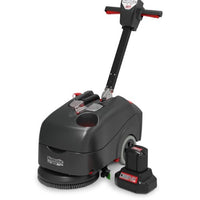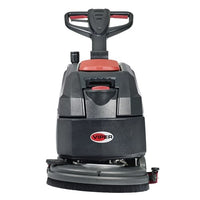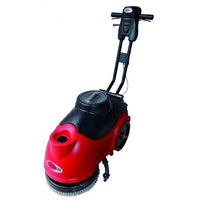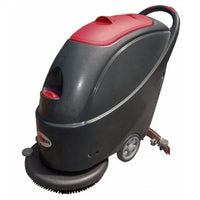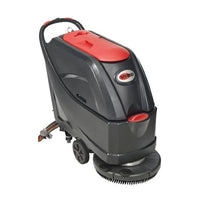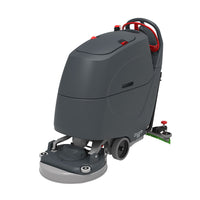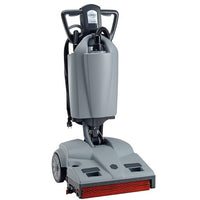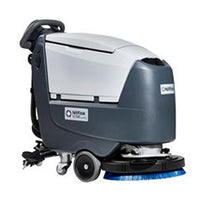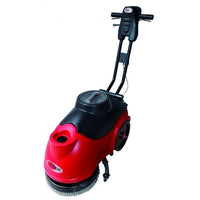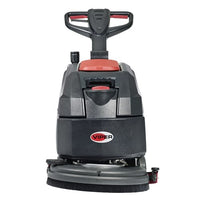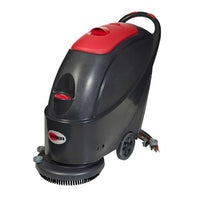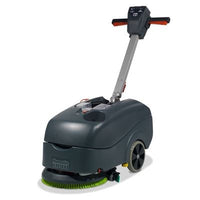Collection: Scrubber Dryer Machines
Comprehensive range of professional floor scrubber dryer machines designed for efficient commercial cleaning. From compact walk-behind models for confined spaces to industrial ride-on machines for large facilities, our selection ensures optimal cleaning performance, reduced labour costs, and superior hygiene standards across all commercial environments.
Complete the demonstration form here and we can arrange a suitable date time to show you your next cleaning machine.

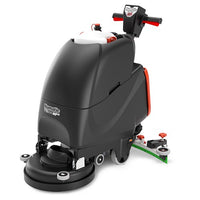
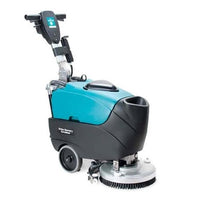
Scrubber Dryer Machine Product information
At ClickCleaning, we've been supplying floor scrubber dryer machines to businesses across the UK for years, and we understand that choosing the right machine can feel overwhelming. That's why we've carefully selected our range to include everything from compact walk-behind models that navigate tight retail spaces to powerful ride-on machines that make quick work of warehouse floors.
For those new to scrubber dryers, these machines represent a significant advancement over traditional mopping methods. Rather than pushing dirty water around your floors, scrubber dryers apply fresh cleaning solution, scrub with rotating brushes or pads, and immediately vacuum away the dirty water. The result is floors that are genuinely clean, dry, and safe to walk on within minutes. We've seen facilities reduce their cleaning time by up to 80% whilst achieving consistently superior results.
Our walk-behind scrubber dryer range suits most commercial applications perfectly. These machines excel in areas up to approximately 5,000 square metres, making them ideal for retail stores, schools, medical centres, office buildings, and similar facilities. With working widths ranging from 35cm to 85cm, we stock models to suit virtually any space and cleaning requirement. The compact models navigate standard doorways and clean effectively along edges and into corners, whilst our larger walk-behind units deliver impressive productivity without sacrificing manoeuvrability. Tank capacities vary from 10 litres on compact models to 100 litres on larger machines, reducing refill frequency and maximising productive cleaning time.
For larger facilities - warehouses, manufacturing plants, distribution centres, and substantial retail spaces - our ride-on scrubber dryers deliver exceptional productivity gains. These machines feature working widths from 65cm to 130cm and tank capacities extending to 300 litres, enabling extended cleaning runs without interruption. More significantly, ride-on operation eliminates operator fatigue associated with walking miles behind a machine during each shift. The productivity improvements and labour cost reductions often justify the higher initial investment within months rather than years.
Power source selection significantly impacts operational flexibility and efficiency. Our battery-powered models have benefited enormously from recent technological advances, particularly lithium-ion battery development. These machines provide complete freedom from trailing cables, making them perfect for daytime cleaning operations and large open spaces where power access proves challenging. Modern battery technology delivers up to 4 hours of continuous operation, with rapid charging capabilities that minimise downtime. Our mains-powered alternatives continue to serve specific applications well, particularly in smaller facilities with convenient power access where the lower initial investment and consistent power delivery provide tangible benefits.
Brush system selection often causes confusion, but understanding your floor types simplifies the decision considerably. Our disc brush machines excel on smooth surfaces, using circular brushes or pads rotating horizontally to provide consistent, controlled cleaning action. These systems work brilliantly on vinyl, sealed concrete, marble, and ceramic tiles, with quick pad changes enabling transition between daily maintenance and periodic deep cleaning tasks. Cylindrical brush machines serve different needs, featuring contra-rotating brushes that sweep debris forward into collection hoppers whilst delivering aggressive scrubbing action. These machines transform cleaning operations on textured floors, safety flooring, and areas with significant debris accumulation.
Selecting appropriately sized equipment requires careful consideration of multiple factors beyond simple floor area calculations. Facility layout significantly impacts equipment choice - a 5,000 square metre warehouse with wide, clear aisles requires different equipment than a similarly sized office building filled with furniture, corridors, and obstacles. Cleaning frequency also influences equipment selection, as daily maintenance cleaning often succeeds with smaller, more agile machines, whilst weekly deep cleaning operations benefit from larger equipment that completes work efficiently within available time windows.
Modern scrubber dryers incorporate numerous features that enhance operator comfort and cleaning effectiveness. Intuitive control systems reduce training requirements and operator errors, whilst adjustable components accommodate different operators comfortably. Low noise levels enable daytime cleaning without disrupting building occupants, and excellent visibility reduces accident risks. We recommend involving your cleaning team in equipment selection, as their comfort and confidence with the chosen machines directly impacts cleaning quality and efficiency.
Maintenance considerations deserve attention during selection, as ease of maintenance directly affects long-term reliability and costs. Look for machines featuring tool-free brush changes, easily accessible squeegees, and transparent tanks that simplify inspection and cleaning. Clear diagnostic systems that indicate maintenance requirements or identify problems save valuable time and prevent minor issues escalating into major repairs.
Environmental responsibility increasingly influences equipment selection, and modern scrubber dryers deliver impressive environmental benefits. These machines use significantly less water and chemical than traditional cleaning methods, with automatic dosing systems preventing waste through accurate dilution control. Many models feature eco-modes that reduce consumption without compromising cleaning quality, whilst some advanced machines incorporate water recycling systems that filter and reuse water multiple times, particularly valuable where water access is restricted or environmental goals are prioritised.
Whether maintaining pristine retail environments, ensuring industrial facilities meet safety standards, or delivering the highest hygiene levels in healthcare settings, our floor scrubber dryer range provides the performance, reliability, and efficiency your operation demands. Our experienced team regularly helps facilities select optimal equipment for their specific requirements, and we're always available to discuss your cleaning challenges and recommend appropriate solutions from our comprehensive range.
Scrubber Dryer Machine FAQs
What's the difference between walk-behind and ride-on scrubber dryers?
This fundamental question shapes many equipment decisions, and understanding the distinctions ensures optimal selection for your specific requirements. Walk-behind scrubber dryers require operators to walk behind the machine during cleaning operations, providing exceptional manoeuvrability and precise control. These machines navigate
expertly around obstacles, clean effectively under furniture and fixtures, and access corners that larger machines cannot reach. We typically recommend walk-behind models for facilities up to 5,000 square metres, though complex layouts may benefit from their agility regardless of size.
Ride-on scrubber dryers position operators on seated or standing platforms, transforming productivity potential for larger cleaning operations. When cleaning extensive floor areas, operator fatigue significantly impacts cleaning quality and efficiency. Ride-on machines address this challenge whilst delivering impressive productivity gains - typically achieving 3,000 to 7,000 square metres per hour compared to 1,000-2,500 for walk-behind models. These productivity differences compound over full shifts, making ride-on machines economically attractive for appropriate applications.
Manoeuvrability trade-offs require honest assessment. Walk-behind machines deliver superior agility, turning within their own length and cleaning tight against walls and fixtures. For retail environments operating during trading hours, or facilities with complex layouts, this manoeuvrability proves invaluable. Ride-on machines require more generous turning space and cannot access the tightest spots, though modern designs have improved significantly with enhanced visibility and surprisingly tight turning capabilities.
Investment levels differ substantially between categories. Walk-behind machines typically range from £2,000 to £10,000, whilst ride-on models start around £10,000 and extend to £50,000 for premium specifications. However, calculating true cost requires considering productivity gains and labour savings over equipment lifetime. High-utilisation facilities often achieve payback within six to twelve months through labour cost reductions alone.
Many successful operations employ both machine types strategically - ride-on units for main floor areas and walk-behind models for detailed work and confined spaces. This combination maximises efficiency whilst ensuring comprehensive cleaning coverage throughout the facility.
How do I choose the right size scrubber dryer for my facility?
Selecting optimal machine size requires systematic evaluation of multiple factors beyond simple floor area measurements. We guide customers through a structured assessment process that consistently delivers successful equipment choices.
Begin with accurate measurement of cleanable floor areas, excluding carpeted sections, stairs, and permanently obstructed spaces. This baseline figure provides initial guidance but represents only the starting point for proper sizing decisions. Physical constraints often prove more limiting than total area - we recommend carefully measuring doorway widths, lift dimensions, corridor widths, and turning spaces throughout your facility. Standard UK doorways typically measure 76cm, but service areas and older buildings may present tighter restrictions.
Working width directly correlates with cleaning productivity. Our 50cm machines clean approximately 2,000 square metres hourly under ideal conditions, whilst 75cm models achieve 3,000 square metres. However, real-world productivity typically reaches 70% of theoretical maximums due to obstacles, edge work, and overlap requirements. This realistic assessment prevents disappointment and ensures adequate time allocation for cleaning tasks.
Tank capacity significantly impacts operational efficiency through refill frequency. Generally, one litre of solution cleans 50-70 square metres, varying with soil levels and floor types. Calculate your typical cleaning run requirements and select tank sizes that minimise interruption. Frequent refills waste time and disrupt cleaning rhythm, particularly problematic when water sources are distant from cleaning areas.
Available cleaning windows substantially influence size selection. Facilities with limited cleaning time require maximum
productivity from larger machines, whilst continuous cleaning operations may prioritise smaller, less disruptive equipment. We've helped numerous facilities optimise their cleaning schedules through appropriate equipment selection, sometimes discovering that different thinking about cleaning times opens new equipment possibilities.
Future requirements deserve consideration without overspecification. Planned facility expansions or contract growth may justify selecting larger equipment now, avoiding premature replacement. However, we caution against purchasing oversized machines for hypothetical future needs that may never materialise. Balance current requirements with realistic growth projections for optimal long-term value.
Storage practicalities often receive insufficient attention during selection. Larger machines require dedicated parking areas with appropriate charging facilities and maintenance access. Ensure adequate space exists before committing to larger models that might prove problematic to accommodate.
What's the difference between disc and cylindrical brush systems?
Understanding brush system differences enables informed selection based on your specific floor types and cleaning challenges. Both systems excel in appropriate applications, making floor type assessment crucial for optimal results.
Disc brush systems represent the traditional and most versatile approach. These systems employ circular brushes or pads rotating horizontally against floor surfaces, delivering consistent pressure and controlled cleaning action. The flat rotation pattern provides uniform results across smooth floors, making disc systems ideal for vinyl, sealed concrete, polished surfaces, and ceramic tiles. Quick pad changes enable rapid transition between cleaning tasks - from gentle daily maintenance with red pads to aggressive stripping with black pads, all using the same machine.
Cylindrical brush systems operate on entirely different principles. Twin contra-rotating brushes spin like horizontal rollers, creating aggressive cleaning action whilst simultaneously sweeping debris forward into integrated collection hoppers. This dual action eliminates pre-sweeping requirements in many facilities, delivering significant time savings. The aggressive brush action penetrates surface textures, grout lines, and safety floor profiles where disc systems might simply skim across the surface.
Cleaning effectiveness varies dramatically between systems depending on floor characteristics. Disc systems excel at maintaining smooth surfaces, delivering consistent results without risk of damage to delicate finishes. The controlled action preserves floor coatings whilst removing soil effectively. Cylindrical systems provide superior performance on textured surfaces, heavy soil conditions, and areas with debris accumulation. Manufacturing facilities, warehouses, and outdoor areas often benefit significantly from cylindrical brush capabilities.
Debris handling represents a major differentiation point. Disc systems require pre-sweeping when significant debris exists, as they simply push larger particles around rather than collecting them. Cylindrical systems actively collect debris during cleaning, potentially eliminating entire pre-sweeping operations. We've seen facilities reduce total cleaning time by 50% through this single advantage.
Maintenance requirements differ between systems. Disc pads require regular replacement as consumable items, though individual pad costs remain modest. Pad inventory management and proper selection for different tasks requires attention. Cylindrical brushes last considerably longer but cost more when replacement becomes necessary. Additionally, debris hoppers require regular emptying and cleaning to maintain performance.
Our recommendation depends entirely on your floor types and cleaning challenges. Facilities with predominantly smooth floors requiring versatile cleaning options typically prefer disc systems. Operations dealing with textured floors, heavy debris, or seeking to eliminate pre-sweeping usually find cylindrical systems deliver superior value despite higher initial costs.
How long do scrubber dryer batteries last and what types are available?
Battery technology fundamentally impacts scrubber dryer performance, operational costs, and cleaning flexibility. Understanding available options enables informed decisions that affect long-term operational efficiency.
Traditional wet lead-acid batteries remain popular due to proven reliability and lower initial costs. These batteries typically deliver 3-4 hours runtime and last 3-5 years with proper maintenance. However, they require disciplined maintenance routines including regular water level checks, equalisation charging, and careful handling to prevent acid spills. Despite these requirements, wet lead-acid batteries provide dependable service when properly maintained.
Maintenance-free AGM (Absorbed Glass Mat) batteries eliminate the most burdensome maintenance tasks whilst delivering similar performance. The sealed construction prevents acid spills and eliminates watering requirements, making them ideal for facilities where multiple operators use equipment or maintenance discipline varies. Costing approximately 30% more than wet batteries, AGM types justify their premium through reduced maintenance labour and improved safety.
Gel batteries represent premium sealed battery technology, offering superior deep-discharge tolerance and extended lifespan of 4-7 years. Their sealed construction and stability make them particularly suitable for machines operating on inclines or in temperature extremes. However, sensitivity to charging voltages requires compatible charging systems, and costs significantly exceed standard batteries.
Lithium-ion technology transforms operational possibilities despite substantial initial investment. These advanced batteries charge completely in 2-3 hours versus 8-12 hours for lead-acid types, whilst lasting 8-10 years with minimal maintenance. Consistent power delivery throughout discharge cycles maintains cleaning performance, unlike lead-acid batteries that gradually lose power. Although costing £2,000-5,000 versus £300-800 for traditional batteries, operational advantages often justify the investment.
Runtime expectations vary with machine size and workload. Compact walk-behind machines typically operate 2-3 hours per charge, whilst larger ride-on models with multiple batteries extend runtime to 4-6 hours. Lithium technology's rapid charging enables opportunity charging during breaks, effectively doubling daily availability compared to traditional batteries requiring overnight charging.
Total cost analysis reveals surprising results. While lithium batteries cost significantly more initially, their extended life, reduced maintenance, increased availability, and consistent performance often deliver lower lifetime costs. Facilities with intensive cleaning requirements particularly benefit from lithium technology's operational advantages.
Battery selection ultimately depends on your operational patterns, budget constraints, and performance requirements. Traditional batteries suit facilities with predictable overnight charging windows and disciplined maintenance programmes. Lithium technology benefits operations requiring maximum flexibility, minimal downtime, or struggling with maintenance consistency.
What daily maintenance does a scrubber dryer need?
Proper daily maintenance distinguishes scrubber dryers that deliver years of reliable service from those requiring frequent repairs and early replacement. Our experience shows that investing 15-20 minutes daily in maintenance prevents most common problems and extends equipment life dramatically.
Recovery tank maintenance tops the priority list. This tank collects all dirty water during cleaning, and neglecting it creates unpleasant odours and bacterial growth. Empty the tank completely after each use, rinse thoroughly with clean water, and inspect the lid seal for damage. Damaged seals reduce vacuum efficiency, causing poor water pickup and streaky floors that undermine cleaning quality.
Squeegee blade condition directly impacts cleaning results. These rubber blades endure constant floor contact and debris impact, making daily inspection essential. Remove squeegees using the tool-free mechanisms on modern machines, rinse away debris, and examine for nicks, tears, or worn edges. Most squeegees offer four usable edges - rotating them maximises lifespan and maintains consistent performance. Replace damaged blades immediately to prevent streaking and ensure professional results.
Solution tank cleanliness prevents bacterial growth and chemical residue buildup. Drain remaining solution daily rather than storing diluted chemicals overnight. Rinse thoroughly with clean water and leave caps open for complete drying. This simple practice prevents odour development and maintains tank hygiene.
Brush and pad maintenance ensures consistent cleaning performance. Remove brushes or pads after each shift, removing accumulated debris and inspecting for wear. Worn brushes reduce cleaning effectiveness and may damage floors if bristles become uneven. Proper storage prevents bristle deformation - hang brushes or store them bristle-up to maintain shape. Pad washing extends life and maintains performance - we recommend maintaining multiple sets for rotation.
Filter maintenance prevents expensive vacuum motor damage. Clogged filters reduce suction performance and force motors to work harder, potentially causing premature failure. Remove filters daily, rinse thoroughly, and inspect for tears or permanent blockage. Some machines feature multiple filters - check all locations to maintain optimal performance.
Battery maintenance varies by type but remains crucial for all technologies. Wet batteries require water level checks and
terminal cleaning. AGM and gel batteries need terminal inspection and connection tightening. Even maintenance-free batteries benefit from visual inspection and ensuring proper charging procedures. Correct battery maintenance dramatically extends battery life and maintains consistent performance.
Complete machine inspection during daily maintenance reveals developing issues before they become serious problems. Wipe down the entire machine, checking for leaks, loose components, or unusual wear. Ensure parking procedures raise brushes and squeegees to prevent permanent deformation. These simple steps maintain equipment in peak condition whilst identifying potential problems early.
Can scrubber dryers be used on all floor types?
Whilst scrubber dryers demonstrate remarkable versatility across numerous floor types, understanding compatibility ensures optimal results without surface damage. Our experience helping facilities maintain diverse flooring provides clear guidance on appropriate applications.
Vinyl, linoleum, and luxury vinyl tiles represent ideal surfaces for scrubber dryer cleaning. These resilient materials tolerate moisture exposure and mechanical action whilst responding excellently to proper cleaning techniques. Using appropriate brushes or pads with neutral cleaners maintains appearance without premature wear. These surfaces form the backbone of commercial flooring precisely because they pair so well with efficient cleaning methods.
Sealed concrete floors found in warehouses, retail spaces, and industrial facilities handle scrubber dryer cleaning
exceptionally well. The durable surface tolerates aggressive cleaning when necessary whilst maintaining appearance with routine maintenance. Proper chemical selection ensures seal preservation whilst delivering required cleaning performance.
Ceramic and porcelain tiles, including both smooth and textured varieties, suit scrubber dryer cleaning perfectly. The key
lies in selecting appropriate brush systems - cylindrical brushes excel at grout line cleaning, whilst disc systems maintain smooth tile surfaces effectively. Chemical compatibility with grout sealers requires consideration to prevent degradation.
Natural stone floors including marble, granite, and terrazzo demand careful approach but clean beautifully with proper techniques. pH-neutral, stone-specific chemicals prevent etching or dulling, whilst soft brushes or white pads provide effective cleaning without surface damage. Water control prevents penetration into unsealed areas that might cause staining or structural issues.
Epoxy and resin flooring systems common in healthcare and food processing facilities respond well to scrubber dryer cleaning. These seamless surfaces benefit from consistent cleaning that maintains slip resistance and hygiene standards. Chemical selection requires care to avoid solvents that might soften or damage coating systems.
Safety flooring with raised profiles specifically designed for slip resistance requires cylindrical brush systems for effective cleaning. The aggressive brush action penetrates the anti-slip texture where soil accumulates, maintaining both appearance and safety performance. Disc systems prove ineffective on these specialised surfaces.
Wooden floors generally prove unsuitable for scrubber dryer cleaning unless professionally sealed to withstand moisture exposure. Even well-sealed wood requires minimal water application and immediate recovery. Most wooden floors benefit more from specialised wood floor cleaning methods.
Carpeted areas fall completely outside scrubber dryer capabilities. These machines lack the extraction power and brush design required for carpet cleaning. Attempting carpet cleaning with scrubber dryers risks damage and delivers poor results.
Understanding your specific floor types enables proper equipment selection and technique development. When uncertainty exists, testing in inconspicuous areas prevents costly mistakes. Our team gladly assists with floor type identification and appropriate cleaning method recommendations.
What's the typical return on investment for a scrubber dryer?
Calculating return on investment for scrubber dryer purchases reveals compelling financial benefits that often surprise facility managers. Our experience with hundreds of implementations provides clear evidence of rapid payback periods and substantial long-term savings.
Labour cost reduction drives primary returns. Manual mopping typically achieves 200-300 square metres hourly, whilst our scrubber dryers deliver 1,000-7,000 square metres depending on model selection. This 5-20x productivity improvement translates directly to reduced labour hours and costs. Consider a 2,000 square metre facility requiring daily cleaning: manual methods need approximately 8 hours at £12 per hour, totalling £96 daily or nearly £25,000 annually. The same area cleaned with an appropriate scrubber dryer requires just 1-2 hours, reducing annual labour costs to £3,000-6,000 and
generating savings of £19,000-22,000.
Initial equipment investment varies by model type and specification. Our walk-behind range spans £2,000-10,000, whilst ride-on models range £10,000-50,000. Quality machines deliver 7-10 years of reliable service with proper maintenance, spreading initial costs across extended periods. When annual savings reach £20,000, even premium models achieve payback within months rather than years.
Operational costs remain surprisingly modest compared to savings generated. Annual expenses typically include batteries (£300-800 every 3-5 years), brushes and pads (£200-500), squeegees (£100-200), routine maintenance (£300-1,000), and cleaning chemicals (£500-2,000). Total annual operational costs rarely exceed £2,000-3,000, maintaining strong positive returns.
Hidden savings often exceed visible labour reductions. Chemical efficiency improves through accurate dosing systems, reducing waste by 20-30%. Water consumption decreases 50-70% compared to traditional mopping. Consistent cleaning quality reduces complaint handling time and improves customer satisfaction. Better floor maintenance extends flooring life, deferring replacement costs.
Health and safety improvements generate additional returns through reduced slip accidents from properly dried floors, decreased manual handling injuries, and improved hygiene from eliminating dirty mop water. Insurance premium reductions and decreased injury claims provide quantifiable benefits beyond direct labour savings.
Typical payback periods range from 6-18 months depending on usage intensity. High-traffic retail environments often achieve 6-month payback through intensive daily use. Weekly-cleaned facilities might extend to 18 months but still generate compelling returns. Most facilities report 200-400% annual ROI when considering all cost factors.
Quality improvements, whilst harder to quantify financially, deliver substantial business value. Professional appearance enhances brand image, consistent cleanliness improves employee morale, and superior hygiene supports health outcomes. These soft benefits complement hard financial returns to create compelling investment cases.
How much water and chemical do scrubber dryers use?
Understanding water and chemical consumption helps optimise operational costs whilst maintaining cleaning effectiveness. Our scrubber dryers deliver significant consumption reductions compared to traditional methods, supporting both financial and environmental objectives.
Water consumption typically ranges from 0.5-2 litres per 100 square metres cleaned, depending on soil levels and machine settings. This represents 50-70% reduction compared to traditional mopping methods consuming 3-5 litres per 100 square metres. Low moisture settings for routine maintenance use just 0.5 litres, medium settings for normal soiling require 1 litre, whilst heavy industrial soiling might need 2 litres per 100 square metres.
Machine tank capacities determine operational range between refills. Our compact models with 10-40 litre tanks clean 500-2,000 square metres per fill, whilst larger machines featuring 100-300 litre capacities cover 5,000-15,000 square metres. Selecting appropriate tank sizes minimises refill interruptions and maximises productivity.
Chemical consumption depends on dilution rates and soil conditions. Modern automatic dosing systems maintain accurate dilution between 0.5-2%, preventing waste from manual mixing errors. A 5,000 square metre facility typically uses 0.5-2 litres of concentrated chemical daily, costing £2-8 depending on product selection. Manual cleaning of the same area often consumes 2-5 litres through inconsistent dilution.
Environmental considerations increasingly influence chemical selection. Low-foam, biodegradable formulations work effectively at lower concentrations, reducing environmental impact without sacrificing performance. Some facilities successfully implement ionised water systems that eliminate chemical use entirely, though these require specific equipment investment.
Advanced water recycling systems available on premium models filter and reuse water multiple times, reducing consumption by up to 85%. These systems prove particularly valuable in facilities with limited water access or strong environmental commitments. While requiring higher initial investment, operational savings and environmental benefits often justify the cost.
Consumption optimisation requires matching settings to actual soil levels rather than using maximum settings by default. Training operators to assess conditions and adjust accordingly prevents waste whilst maintaining cleaning quality. Regular maintenance ensures systems operate efficiently without leaks or excessive consumption.
Cost calculations combining water and chemical expenses typically show £0.01-0.03 per square metre annually for scrubber dryer cleaning versus £0.05-0.10 for manual methods. These operational savings compound over time, contributing significantly to overall return on investment.
What safety features should I look for in a scrubber dryer?
Safety features in modern scrubber dryers protect operators, pedestrians, and facilities whilst ensuring compliance with health and safety requirements. Our range incorporates comprehensive safety systems that prevent accidents and support professional cleaning operations.
Emergency stop mechanisms provide critical protection during unexpected situations. Our machines feature prominently positioned emergency stops that immediately halt all functions when activated. Operators can reach these controls instinctively, preventing escalation of dangerous situations. Recovery procedures are straightforward, allowing rapid
resumption once hazards are addressed.
Automatic shut-off systems prevent costly water damage and safety hazards. Float switches in recovery tanks stop vacuum motors when capacity is reached, preventing overflow that could damage motors or create slip hazards. This protection operates independently of operator attention, providing failsafe overflow prevention.
Machine visibility significantly impacts operational safety. Our range features low-profile designs maximising operator
sightlines, strategic mirror placement for blind spot elimination, and LED lighting for dim environments. Enhanced visibility reduces collision risks and improves cleaning quality through better surface observation.
Non-marking tyres and squeegees protect floor surfaces whilst preventing safety hazards. Grey or white wheels eliminate unsightly marks that require additional cleaning, whilst quality squeegees prevent scratching of delicate surfaces. These features maintain facility appearance whilst preventing damage claims.
Noise levels affect both operator welfare and facility disruption. Our machines operate below 70 decibels, preventing hearing damage during extended use whilst enabling daytime cleaning without disturbing building occupants. Quiet operation expands cleaning windows and improves workplace environments.
Stability engineering prevents tipping accidents that could injure operators or damage property. Low centres of gravity, appropriate weight distribution, and anti-tip wheels on ride-on models ensure safe operation even on inclines or uneven surfaces. Stability remains consistent whether tanks are full or empty.
Electrical safety features include proper grounding systems, circuit protection preventing overloads, and sealed components preventing water ingress. Battery compartments incorporate adequate ventilation preventing gas accumulation during charging cycles. These systems meet or exceed relevant safety standards.
Control ergonomics significantly impact safe operation. Intuitive control placement prevents operator distraction, whilst dead-man switches ensure machines stop immediately when operators release controls. Clear labelling and logical control grouping minimise operation errors that could create hazards.
Chemical safety provisions include secure tank caps preventing spills during operation, clear labelling systems preventing chemical mix-ups, and controlled dosing preventing exposure to concentrated chemicals. Some models feature lockable chemical compartments preventing unauthorised access or tampering.
Training support enhances all safety features. We provide comprehensive operator training covering safe operation procedures, hazard recognition, and emergency responses. Proper training transforms safety features from passive protections into active safety management tools. Documentation supports compliance requirements whilst ensuring consistent safety standards across all operators.
What are the running costs of a scrubber dryer?
Understanding comprehensive running costs enables accurate budgeting and informed investment decisions. Our experience helping facilities track operational expenses reveals that scrubber dryers deliver excellent value despite various ongoing costs.
Electricity expenses for battery charging represent a primary operational cost. Daily charging typically consumes 5-20
kWh depending on machine size and battery type, translating to £0.50-2.00 at current electricity rates. Annual electricity costs range from £150-500 for most machines - a minimal expense compared to labour savings achieved.
Battery replacement constitutes the largest periodic expense. Lead-acid batteries costing £300-800 require replacement every 3-5 years with proper maintenance. Lithium batteries represent higher initial investment at £2,000-5,000 but last 8-10 years, often proving more economical when calculating cost per year of service. Battery maintenance quality significantly impacts replacement frequency.
Consumable components require regular replacement to maintain cleaning performance. Brushes typically last 400-800 operating hours, requiring annual replacement costing £200-500 depending on machine size. Pad users budget £100-300 annually, as pads require monthly replacement with daily use. Squeegee blades last 6-12 months with proper rotation, costing £100-200 annually for replacement sets.
Chemical expenses vary considerably based on facility size, soil levels, and product selection. Most facilities spend
£500-2,000 annually on cleaning chemicals, with concentrated products providing better value than ready-to-use alternatives. Automatic dosing systems prevent waste, potentially reducing chemical costs by 20-30% through accurate dilution.
Routine maintenance parts include filters (£50-100 annually), hoses (£50-150 annually), and miscellaneous components (£100-300 annually). Preventive maintenance reduces unexpected failure costs whilst maintaining optimal performance. Quality machines require fewer replacement parts, justifying premium initial investment.
Service contract options provide maintenance cost predictability. Annual contracts ranging £500-2,000 include labour and parts for routine maintenance and repairs. These agreements often prove economical by preventing major repair expenses whilst ensuring priority service response. Facilities with critical cleaning requirements particularly benefit from service contract protection.
Labour costs for daily maintenance average 15-20 minutes at standard wages, totalling approximately £1,000-2,000 annually. This investment in preventive maintenance prevents costly breakdowns and extends equipment life significantly. Operator training reduces maintenance time through efficient procedures.
Insurance and extended warranty options add £200-1,000 annually but protect against major repair costs that could exceed annual premiums. Equipment breakdown coverage proves particularly valuable for expensive ride-on machines where repairs might reach thousands of pounds.
Total annual running costs typically range £2,000-5,000 for walk-behind machines and £3,000-10,000 for ride-on models. These figures include all consumables, maintenance, and operational expenses. When compared to labour savings often exceeding £20,000 annually, running costs remain highly favourable.
Calculating cost per square metre cleaned provides meaningful comparison metrics. Most facilities achieve operational costs of £0.002-0.005 per square metre cleaned, comparing favourably to manual cleaning at £0.01-0.02 per square metre. This 75-90% reduction in cleaning costs validates scrubber dryer investment across virtually all commercial applications.



